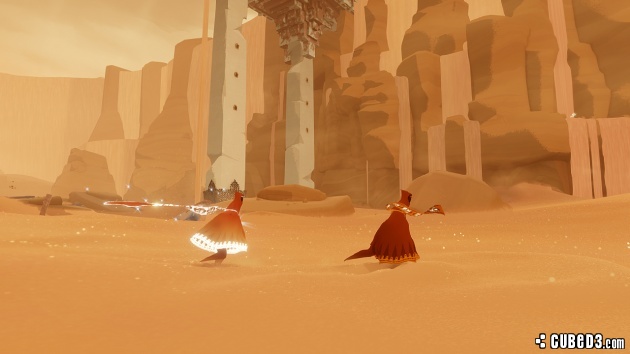Journey (PlayStation 3) Review
By Jamie Greenhill  25.02.2013
25.02.2013

Journey, the game some people have described a little unfairly as a walking simulator, is Sony's reward for its substantial investment in young talent. It's the third game from the imagination of thatgamecompany (TGC), with the other two being the well received Flower and flOw. Not having played the previous two titles, personally this 'Journey' began whilst slogging through Xenoblade. Hunting for black liver beans one day, a video was spied in the peripheral vision of potential dark horses of 2012. The words 'Journey', 'interesting co-op' and 'PSN' were uttered, and it was all that was needed before downloading it. If those reading this enjoy atmospheric games, stop reading now and go into this game with same minimal amount of information - there will be no regrets!
For those that have decided to stick around, however, on paper there's not actually too much to Journey. The main goal of the game is simply to get to the top of a mountain. The second, more interesting objective, though, is to discover why climbing the peak is a necessity in the first place. It is basically two hours of walking, floating and falling around a beautiful landscape. The only thing the player really does is activate the occasional switch and collect glyphs that extend the main character's scarf. The longer the scarf, the further the lead can float; that's pretty much it. Therefore, it's the same length as most movies and has very little in the way of actual gameplay; so why all the awards and hype? Well...
To start with when saying 'two hours of wandering around a beautiful landscape,' the emphasis is definitely on beautiful. It is easily the prettiest game to have been released last year. Everything from the sand physics to the heat haze and through to the striking background art is top tier, and together they produce a landscape like no other; never has a desert looked so vibrant. For a game set in a scorched wasteland, the world feels oddly aquatic. Strands of cloth peek out of the sand dunes, swaying in the breeze like seaweed, whilst strange cloth creatures swim about ruins like shoals of fish and the main character surfs over the dunes like waves in the ocean.
Keeping to the world's aesthetic theme, the main character in Journey is cloaked head to toe in brown cloth. At first glance, just like the game itself, he looks very simple. However, when wandering through the sand sea the little extra touches start to become apparent. Details like how his cloak reacts to the wind or how his scarf wraps around another player's avatar, for instance, are mesmeric. Everything from the wanderer straining to climb a steep hill, to sliding down a river of sand feels incredibly natural. The way the Jawa-like creature moves feels a lot less rigid than most videogame protagonists; never does it feel like merely pushing him in one of eight directions.
A key reason for this is the game's camera; it feels like it's always on the move. A lot of time has clearly been put into positioning it so that the player gets the best possible view of the world. Travel from one memorable scene to the next with no downtime with each segment feeling very distinct. A lot of credit must go to the guys in charge of lighting as it all looks incredibly cinematic...and then a gentle nudge of the analogue stick and surprise, surprise you still have control. The way the game blurs the line between cut-scenes and gameplay is very impressive. Instead of trying to create a twelve-hour game, which looks nice for a downloadable title, the development team has crafted a two-hour game, which outshines big budget blockbusters in many ways.

However, enough about the visuals! What makes Journey truly unique is not the grand vistas or the well-placed cameras but in the way online co-operative mode is handled. Everyone knows the surefire way to kill an atmospheric experience is to add a second player to the mix *Looks forlornly at Dead Space and Resident Evil* Let's face it, listening to someone play One Direction into their microphone or telling you what to do in 'txt sp3@k' tends to ruin the ambiance. Thankfully, TGC came up with a clever solution. The team allows for communication, but in a way that complements the experience. With the press of a button, the character will let out a chirp. The longer the button is held down, the louder the noise will be. Simple but effective, the system allows players to grab someone's attention, say hello, goodbye and thank you, all without a single word actually being said.
The various different chirps also serve as a way to interact with the environment. They are used to energise murals that explain the game's story. It feels very Metroid Prime-esque, in that the level of involvement is decided by the individual. The sound waves also recharge the power of a companion's scarf, allowing them to float further. This means the desert can be traversed in half the time with an anonymous friend in tow. Once becoming more proficient at co-operating, flying high above the landscape for extended periods of time is a certainty. The bond these mechanics help forge - over a relatively short amount of time - is possibly the most impressive part of the game. Losing track of a partner is genuinely sad and finding them again is a moment of joy that few games can match.
The multiplayer actually adds a strange kind of replay value. The primary role in the game slowly evolves from follower to mentor. With every journey, the player encounters someone new and chances are they will know something new - where a mural is located or a glyph is hidden, for example. It will take a while before the desert wanderer is strutting through the dunes with a fully grown scarf and the knowledge of what happened to the world. There's a nice little reward that reflects this, in the form of a fancy white cloak. It's an interesting mechanic, which means the game doesn't have to end when the credits roll.
When the credits do roll for the first time, though, and Austin Wintory's 'I Was Born for This' begins to play, it hits hard. Some people have said the ending sequence moved them to tears, which is a tad extreme, yet it is indeed one of those 'arm hairs standing on end' moments. It is then that realisation strikes that something special has just been witnessed; a game like no other. How often does that really get said, truthfully? In an age of sequels, existing franchises, and inspired-bys,' Journey is refreshingly original. Unfortunately, it isn't for everyone; it's a very divisive game.

Cubed3 Rating
Exceptional - Gold Award

As much as Journey is truly magical, it is understandable why some people don't enjoy it. Being very short, lacking in traditional gameplay, and for those without access to online for the co-operative element, only half the experience is...experienced. Whether players get something out of Journey depends heavily on why videogames are played in the first place. It is probably best described as Metroid Prime if all the puzzles and enemies were stripped away, leaving just the exploration of an alien world intact. To a large chunk of people that may sound like an awful idea, but if not in that fairly large chunk, Journey is plain and simple a must buy. Charming from start to finish and one of PSN's most impressive residents.
Comments
Comments are currently disabled

 Sign In
Sign In Game Details
Game Details
 Out now
Out now  Out now
Out now  Out now
Out now  Out now
Out now  Subscribe to this topic
Subscribe to this topic Features
Features





 Top
Top

